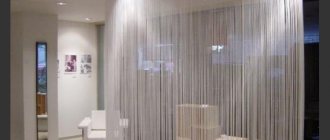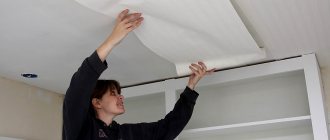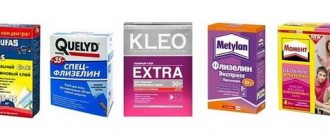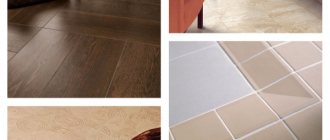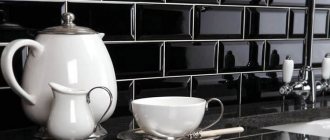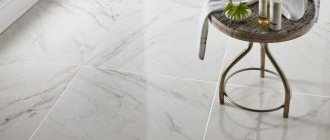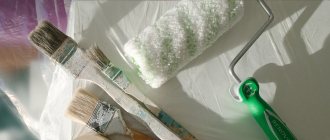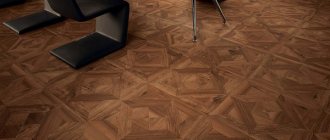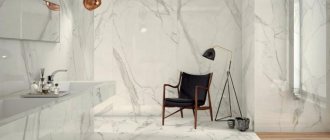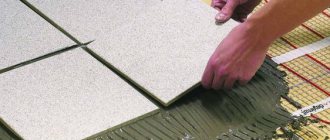There is a wide range of materials available for the design of ceiling surfaces. This could be plastic, vinyl wallpaper or even ordinary plaster.
One solution is foam ceiling tiles . They are affordable, but at the same time practical and very attractive.
General concept, composition, material characteristics, selection features
Among the variety of facing materials, ceiling tiles perform well during repairs. Externally, it is simply a geometric shape, usually a square or rectangle, less often more elaborate design options. The squares have dimensions of 50 x 50 cm or 30x30 cm. The color scheme of the original panels depends on the type of manufacture, and the surface of the front side depends directly on the processing method.
Composition and manufacturing features of the material
Expanded polystyrene is essentially the same polystyrene foam. It is made by foaming the polymer with pentane gas, which is produced at high temperature. In this case, balls filled with air are formed, which stick together into a homogeneous elastic material. Further pressing produces slabs. The uniqueness of the material lies in its composition: 98% air. The raw materials and the production process itself are relatively cheap, which is reflected in the low price of the product. We will consider the advantages and disadvantages of the material in accordance with the existing characteristics inherent in each of its types.
Standard square shape of foam ceiling tiles Source moskvacenter.com
General advantages and disadvantages of polystyrene foam ceiling tiles
Foam ceiling tiles have a number of advantages:
- lightweight and convenient for transportation and installation;
- fire-resistant - due to special treatment with anti-perenon agents;
- resistant to alcohol, alkalis, salts, lime and cement mortars;
- does not rot, is resistant to mold, which allows use in conditions of high humidity;
- withstands temperature changes;
- environmental material;
- possibility of sanitary care;
- possibility of changing color schemes;
- plasticity, possibility of restoration;
- relatively low cost;
- quite long service life.
Along with the advantages, these products also have disadvantages:
- susceptible to organic solvents, gasoline;
- may be deformed under the influence of varnish and some paints;
- not always compatible with expensive designs and some styles;
- fragility, brittleness, susceptibility to mechanical damage and deformation;
- At high temperatures it melts, causing strong smoke.
One of the options for decorating the ceiling with polystyrene foam tiles Source roomester.ru
Safety of polystyrene foam ceilings
Subject to the production, installation and operation technology, foam ceiling panels comply with generally accepted standards. Does not emit toxic substances under standard conditions. The main harmful factor for expanded polystyrene remains exposure to ultraviolet radiation and high temperature. Considering the “airiness” of polystyrene foam, it is considered not flammable, but melting. But, with the use of special anti-perforation treatment, it is difficult to melt high-quality polystyrene foam.
Advantages and disadvantages of ceiling tiles
The advantages of finishing include:
- Resistant to water, steam, condensate. The surface of the tile is covered with a glaze that does not allow water to pass through, so the base ceiling also remains dry.
- Ceramics is considered a natural material that does not cause allergies or other negative phenomena throughout its entire lifespan.
- The service life of the finish reaches several decades.
- Durability of the material. Durable tiles withstand accidental mechanical shocks and are inert to most chemicals, hot steam, and boiling water.
- The tiles can be cleaned using brushes. Only abrasive products are excluded, but it is also permissible to clean with pastes, for example, if you need to clean the kitchen ceiling from dried drops of grease.
- Versatility. Laying tiles is possible on any surface - wooden, concrete, plasterboard or even glass ceilings. All you need is the right glue.
- Shape stability is maintained. The tiles are not afraid of flooding, they do not burn in a fire, and do not lose their geometric evenness under any negative influences.
Important! If light-colored joints have darkened over time, they can be bleached with compounds containing intense bleaches. Suitable products: Whiteness, Domestos, diluted bleach. The joints are treated locally; if the remedies do not help, you can remove the joint compound and re-grout the finish.
The material also has disadvantages:
- High price. Good tiles cannot be cheap due to multiple processing cycles during the manufacturing process. The cost of standard type collections is from $8-10 (from 600 rubles). Individual collections from decorators can cost from $20 (1400-1500 rubles).
- The need to strictly follow the layout technology. If the decor is not secured, the ceilings will collapse, which can lead to serious injuries. The risk of collapse arises not only due to violation of installation technology, but also due to significant shrinkage of the house.
Despite the simplicity of the work, decoration requires certain knowledge and experience. But once you understand the nuances, even a novice master can handle the finishing.
Types of ceiling tiles and how to choose the right one
In a room with high humidity, we take into account the presence of ventilation, exhaust hoods, and the moisture resistance of the tiles. Shake the stamped products and check for breaks, uneven edges, and whether there is a difference in thickness. Form errors are considered defective.
Types of tiles depending on manufacturing method
There are three main varieties:
- Stamped - fragile, 6-8 mm thick, low quality, with a brittle, granular structure: cannot be washed, but can be painted. Cheap. Pressed from foam blocks. It is necessary to pay attention to the identity of the products.
- Injection - durable, white, with a clear pattern, environmentally friendly, 9 - 14 mm thick, moisture-resistant, fireproof, with high heat and sound insulation properties, painted, average price. Produced by sintering. Used when installing a seamless ceiling.
- Extruded – smooth, dense, durable, covered with a protective water- and dust-repellent film. He washes himself. It has minimal thermal conductivity, is resistant to deformation and frost, is easily restored in case of damage, and cuts smoothly and accurately. The curved edges of the ceiling side of the tile hide surface defects. The cost is high. Pressed from polystyrene strips. Once painted or laminated.
Variety of polystyrene ceiling panels Source sdelaipotolok.com
Surface type of foam boards
Ceiling tiles made of polystyrene foam come in matte, glossy, or with a protective coating. The variety of surface types makes it possible to use tiles for utility, domestic premises and living rooms, including bedrooms and children's rooms:
Mirror is an original type of tile with a reflective surface effect that will visually expand the space of the room.
Laminated - an absolutely smooth front side is formed due to a film pressed on top of the product, which protects the tiles from moisture, and its pattern allows you to vary the choice of decor (color, imitation of natural materials - the choice is great). Easy to clean. Suitable for bathrooms, showers and kitchens.
Seamless is a special type of tile that creates the illusion of the integrity of the canvas. This effect is achieved by the shape and clarity of the edge cut in combination with a correctly selected pattern. Ceiling tiles are seamless in name only: the edges fit together so perfectly that the joints are completely invisible. According to the type of production, it is an injection panel that is glued to an exceptionally flat ceiling.
Such different-looking foam ceiling tiles Source kaksdelatpotolok.ru
See also: Catalog of house projects for construction using half-timbered technology
Decor of foam tiles and additional details
The variety of foam ceiling panels concerns not only the production method, but also the appearance. Tiles can give the impression of different materials: marble, wood, iron. Textile-inspired products with a large selection of colors look beautiful; tiles with a printed pattern look unusual.
Corners, ceiling plinths, rosettes and moldings are related parts for installing ceiling tiles.
The correct selection of additional elements, complementing each other, will add style, originality and harmony.
Embossed tiles look like stucco Source img0106o.psstatic.com
Types of ceiling tiles
Today, ceiling tiles are made from different materials: PVC, acrylic, cork, wood and even metal. Foam products remain the most common in our country. But they also have many varieties.
By manufacturing method
Based on production methods, there are three main types of foam finishing.
| Image | Name | Description |
| Pressed | The technology of stamping foam blocks is used in production. The finished element has a thickness of about 8 mm. It can be painted. The disadvantage of the product is the graininess of the surface. It is impossible to create a relief with clear small details on such a ceiling tile. | |
| Extruded | The production uses foamed polystyrene, which is molded in a special machine. The result is elements with a clear texture about 3 mm thick. Such ceiling tiles are characterized by sufficient density, minimal weight and the ability to recover from minor mechanical damage. | |
| Injection | In its production, the technology of sintering polystyrene in special forms is used. Element thickness is from 9 to 14 mm. Such products are produced exclusively in white. The injection model is characterized by increased moisture resistance and excellent sound insulation properties. |
The cheapest of all was pressed ceiling tiles. However, you will have to be extra careful when working with it. Products are fragile and easily damaged. The most durable coating will be made from extruded models. Such products are easy to work with, they are easier to glue to the ceiling and have improved characteristics.
By surface type
The material can also be classified by surface type. In this case, there are three main options.
| Image | Name | Description |
| Laminated | Each product has a coating made of polymer materials. Thanks to this, it acquires a spectacular appearance and is not afraid of high humidity. | |
| Seamless | The difference between such products is the absence of chamfers along the edges. Thanks to this, the finished coating looks like a single canvas, and the seams are almost invisible. Some manufacturers offer models with wavy edges. This also helps to disguise the joints. | |
| Mirror | Has a glossy reflective surface. Such models allow you to visually expand the room. |
Seamless ceiling tiles are the most popular today. If installed correctly, the ceiling will look like stucco. It will be an excellent addition to classic interiors.
Installation of polystyrene foam ceiling tiles
Before gluing foam ceiling tiles, we determine the correct location of the tiles on the ceiling, calculate its quantity based on the parameters of the room and the characteristics of the room and ceiling.
Ways to arrange tiles
From the corner around the perimeter: the ceiling must be ideal in terms of parameters;
Diagonally: in the case of protruding ceiling tiles or other irregularities in the shape of the ceiling. Visually increases the area.
Checkerboard or serpentine: for laying colored slabs.
Number of tiles
Having decided on the design, dimensions, and location of the ceiling panels, we move on to calculating their number, in accordance with the area of the ceiling: on the ceiling drawing, on the same scale, we distribute the slabs in accordance with the sizes. If laying along the perimeter, divide the ceiling area by the area of the slab (specified by the manufacturer). Considering the possibility of damage, errors in calculations, cutting, ensure a supply of material.
See also: Catalog of companies that specialize in finishing materials and related work
Fixing ceiling tiles
Expanded polystyrene ceiling tiles are attached by gluing to the ceiling itself or to the frame. When gluing, you need to decide on an adhesive solution that is suitable for the material of the ceiling and tiles.
This is how easy and simple it is to glue foam tiles Source sense-life.com
Adhesive materials
When choosing a method for gluing tiles to the ceiling, consider the types of mixtures:
- Dry mixtures - fix quickly and firmly, are cheap, economical, but require preparation, final fixation takes up to 3 days;
- PVA glue: white, practically odorless, leaves no marks when dry, but takes a long time to dry, which makes installation difficult and lengthens installation time. The best option is a mixture of PVA, water, and polymer putty;
- “Liquid nails” – universal, convenient, quick fastening, applicable in small areas;
- Polyurethane foam is easy to use, reliable, but with the appearance of voids, long-term fixation, uneconomical, with a high probability of destruction of thermal properties;
- Polyurethane foam - easy to use, economical, quick adhesion, increased moisture resistance - the best option;
- Combined adhesives;
- Adhesives “Universal” and “Moment” are convenient and set quickly; they require increased care in work and may leave marks.
Universal adhesive, easy to use Source guruotdelki.ru
The nuances of gluing flow tiles
Ingredients of adhesive solutions unsuitable for installation of foam tiles
Choosing the right adhesive for ceiling tiles means quality repairs. The peculiarity of working with polystyrene foam products is determined by the composition of the adhesive solutions. Some of them may have a negative effect on the surface of the material. For example, they destroy the structure of the material: ethers, alcohols, amines, chlorine, nitrogen-containing substances, ketones, derivatives of natural gas, hydrocarbons.
How to properly glue ceiling tiles
It is necessary to study the ingredients of the solutions and instructions on how to properly glue ceiling tiles. We pay attention to the cleanliness of the tile and ceiling surfaces. It is possible to apply the prepared mixture to the ceiling and tiles. For quick and high-quality adhesion, we process the ceiling tiles with a needle roller. We mount along the directions pre-marked with a marker.
When working with PVA, let the glue on the tile dry, then press it to the ceiling until it sticks. We apply polyurethane foam along the perimeter and diagonally. Having installed several rows, fill the space between the tiles with foam. If there are large gaps, it is worth cutting out the corresponding parts from the panel.
Variety of adhesives for foam panels Source potolokjournal.ru
Technology for manufacturing foam tiles
Ceiling tiles are made from polystyrene foam using various technologies. Depending on the types, the material receives practical, performance characteristics and is assessed as a budget or more expensive option.
There are three technological manufacturing options:
- Stamping. The process of sintering material poured into molds.
- Extrusion. Foamed polystyrene mixed with nuclear oxide is used. The composition includes elements of talc, oxides of silicon, magnesium, titanium, sand. During the melting process, the components give the finished product a margin of safety and reduce the likelihood of product shrinkage. Each manufacturer has its own nuclear composition, and the practical performance of the finished elements depends on it. The molten mass is passed through a slotted die, then the fragments are cooled, and a finished lamella is obtained.
- Injection. This option involves filling special forms with liquid raw materials, followed by compaction and pressing. The tiles are cooled and hardened under high pressure, which eliminates the possibility of deformation of the finished products and ensures stability of shape during operation.
Expanded polystyrene ceiling for the bathroom: features of selection and installation
When installing an expanded polystyrene ceiling in a bathroom, we do not save on materials, because their quality is always proportional to the price. Features of the operation of the room determine the choice of tiles and adhesive mixtures. The use of injection and pressed tiles is contraindicated. Correctly use laminated boards that are resistant to rot and fungi. It is also necessary to treat the ceiling with special antifungal solutions. Adhesive for ceiling tiles must meet the basic criteria: high adhesion, safety, reliability, moisture resistance, uniform application.
Features of gluing tiles to uneven ceilings
Irregularities in the ceiling may prevent the tiles from adhering securely. It is necessary to understand how to glue ceiling tiles, for example, with small differences, tiles with a thickly applied layer of epoxy adhesive level the surface. But with more pronounced unevenness, the ceiling must be leveled, for example, with a concrete contact mixture. For further work, you need to wait for the surface to harden, and it is also recommended to prime the ceiling to ensure high quality adhesion of the slabs to the ceiling.
Mirrored polystyrene foam ceiling tiles will give the room an original and expensive look Source pobetony.ru
Preparatory work
In order for the tile to lay without flaws, the surface of the ceiling must be perfectly flat. The work is performed using a standard set of tools.
Tools:
- hydraulic level;
- perforator;
- chisel;
- set of spatulas;
- Master OK;
- paint brushes of various widths.
As a rule, cracks appear on the concrete floor at the joints over time, which should be repaired with cement mortar. Next, using a hydraulic level, check the surface level and mark the marking lines on the adjacent walls with a marker. They will serve as beacons when leveling the ceiling.
This method is used when the plane has slight differences, and a thin layer of plaster is enough to level it. Otherwise, it is recommended to level the ceiling using plasterboard.
Frame mount
In case of pronounced defects in the ceiling or, for example, the need to disguise the wiring, the panels are mounted on a frame made of metal or wood. Initially, they determine the area of the ceiling, the location and type of lamps, carry out calculations, and mark out the places for attaching frame structures, which are placed perpendicular to the intended direction of installation of the slabs.
It is recommended to fill the space between the ceiling and the panels with heat-insulating, noise- and vapor-absorbing materials or silicone sealant. The distance between the sheathing bars should not exceed 40 cm. The bars are attached to the ceiling with self-tapping screws or dowels. A properly prepared frame will make it possible to beautifully and efficiently strengthen the tiles. The distance from the ceiling to the plane of the frame should be at least 10 cm when installing built-in lamps.
Installation of the frame begins from the corner of the room, located at the minimum height from the starting profile. Finish by installing the finishing corner, without securing the panel. Distortions of laid panels are not allowed. Upon completion of installation, the ceiling plinth is attached, which decorates the junction of the ceiling panels and walls.
Mounting polystyrene foam boards on the frame will slightly reduce the height of the room, but will hide major defects Source remoo.ru
Painting ceiling tiles
Grayish colored tiles can be repainted. It is recommended to paint ceiling tiles immediately after they are attached. Also, painting is an option for restoring a foam ceiling when the cladding loses its appearance, gets dirty, is not cleaned, needs to restore its waterproof properties and the ability to even out the overall appearance of the ceiling when replacing old slabs with new ones. More often this applies to kitchens and bathrooms: refresh, extend service life, enhance fire safety, water resistance, thermal properties, resistance to fungi, and fading of ceiling panels.
Primary painting of foam boards does not affect adhesion, but secondary painting can significantly worsen it. There will be stains, stains, and unpainted areas if you paint mirrored, laminated and plastic boards. Painting will never help hide cracks and creases in panels. But the cost of restoring the appearance of ceiling tiles by painting consists of the cost of materials (tools, primer, paint), and this is significantly more economical than work (dismantling - installation) with a new coating.
Direction for layer-by-layer painting of a ceiling made of foam tiles with a paint roller Source postroi-sam.info
Types of paint for painting polystyrene foam ceiling tiles
Expanded polystyrene ceiling tiles are painted. You should use the instructions for using foam boards and the following paints:
Water-based - quickly becomes dirty, loses freshness, is not used in a humid environment, but dries quickly, is fireproof, environmentally friendly and easy to apply with a regular brush or roller. The layer is applied evenly when using a spray gun. Painting is carried out on a cleaned and dried ceiling surface, preferably in several layers with drying.
Acrylic - dries quickly, without a pungent odor, hypoallergenic, with a long service life. Combines with acrylic primer. Suitable for painting foam panels in the bathroom. But there is a possibility of paint swelling.
Latex - does not peel off when applied to a dry or wet surface. Dries quickly, is resistant to exposure to the sun, temperature changes, and is suitable for use in different rooms.
It is recommended: close the room until the paint is completely dry, follow the instructions for using paints, and safety precautions when working.
To paint foam tiles in children's rooms and bedrooms, it is necessary to select highly environmentally friendly dyes Source nashaotdelka.ru
Advantages and disadvantages of ceiling tiles
Ceiling tiles are made from polystyrene foam or expanded polystyrene. Modern production technologies make it possible to give the material a variety of textures and colors. Among its main advantages are:
- Ease of installation. Even an inexperienced master can carry out all the work alone.
- Saving room parameters. When installing such finishing, the ceiling height is reduced by only 1-2 cm.
- Sound and heat insulation properties. Expanded polystyrene allows you to retain heat in the room, which will reduce heating costs.
- Low price.
- Low weight. The finishing does not create a load on the floor, which is especially important for old houses. Even if the slab comes off and falls, it will not be able to injure anyone.
If installed correctly, ceiling tiles allow you to obtain a smooth coating without defects. Moreover, all work can be completed in just a few hours.
An important advantage is the environmental friendliness of the material. It does not release any toxic compounds into the air. Therefore, such ceiling tiles can be safely installed even in children's rooms.
The finish is easy to maintain. If heavy dirt appears, just wipe the ceiling with a damp cloth. Proper care and proper installation ensure a long service life for the coating. It can not be changed for 10 years. It will not change its original appearance over the years.
There is no need to putty the ceiling before finishing. Expanded polystyrene tiles perfectly hide small cracks and other defects. But if there are significant unevenness on the ceiling, you will have to carry out preparatory work.
The material is not without its drawbacks. Among the main ones are:
- Low resistance to high temperatures. Contact with heating parts of lamps leads to melting of polystyrene foam and loss of its decorative properties.
- White polystyrene foam can fade in the sun over time and acquire a yellowish tint.
- Fear of mechanical influences. After strong pressure, a visible dent remains on the surface. To correct the situation, a complete replacement of the element will be required.
The disadvantages of this finish include the inability to disguise electrical wiring under it. You will have to hide it in special cable channels that are mounted on top of the finished coating, which does not look very aesthetically pleasing.
